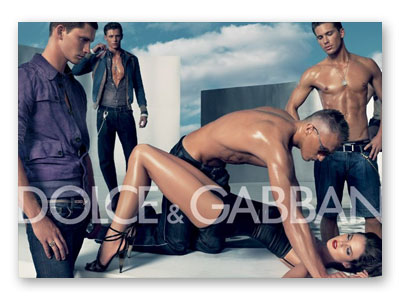Today’s advertising environment is filled with too many messages and not enough attention by consumers. Shock Marketing is a field of marketing that provokes, inspires and stuns the public. This article explores the use and impact of shockvertising in advertising campaigns.
Shockvertising and Shock Marketing are most often thought of and used in Social Marketing campaign. In campaigns against drinking, animal brutality, meat consumption, abortion, racism, climate change and social inequality, advertisers grab headlines and priceless publicity that cannot be bought without the shock value.
This advertisement below by Diesel catered to growing concern over rising sea tides due to climate change, particularly after Al Gore’s movie “An Inconvenient Truth” showed pictures of Manhattan flooding because of global warming. The main message shows irony with having young people having to sunbathe on the top of a roof because of climate change’s flooding of Manhattan skyscrapers. As she pours water into his mouth, it suggests that you can taste the water. While making a statement, it promotes Diesel’s clothing line. Diesel mirrored the same message in other cities showing bathing suits, parrots and penguins in cities like Rio, Venice, and the North pole.
Sex Sells

The old adage goes that sex sells. But shockvertising goes beyond sex to make a statement or invoke powerful imagery to resonate. What shocked Americans in 2009 was a Calvin Klein billboard in Soho in New York City. What was shocking to Americans was not the sexuality, but having two heterosexual men with one woman. A man sleeps on the floor below, giving the impression that he is dreaming of the situation above (supported by the faded dream-like top part of the billboard). Freudian psychologists’ imaginations went wild interpreting the photo, and family groups demanded that the ad be taken down. Though the financial success of the campaign has not been made available, the amount of free publicity was a big boost to Calvin Klein in a selling environment filled with new boutique jean competitors.
Other fashion brands combine shockvertising and suggestive sexuality.

Other brands use symbolism to shock. Here Sisley tries to convey a symbol of urban fashionistas, while shocking the viewer into remember the brand. As Sisley mainly targets large urban centers, Sisley may not expect a large backlash from boycotts and outcries from the public.
Civic Shockvertising
Even municipal governments use innovative shock marketing to prevent people from walking in certain areas. Many governments use shock advertisements to prevent binge drinking, smoking, sexual behavior, and unsafe behavior.

Governments Can Use Shockvertising
Below is an example of shockvertising sponsored by the Australian government.


Guerilla Marketing and Smoking
“Truth” uses guerrilla marketing techniques to shock people to stop smoking. This technique involved writing on toilet paper about how ammonia, used to clean toilet bowls, is in cigarettes.

Animal Welfare and Shockvertising
Animal cruelty organizations use Shock Marketing to demonstrate their case.
Another shocking advertisement about animal cruelty and children’s suckling on battered animals.
The History of Shockvertising
The ‘90’s saw the emergence of all things ‘shock.’ Shock-rocker, Marilyn Manson, pushed the boundaries of artistic sensibilities just as his inspiration, Alice Cooper, had done in the ‘70’s. Broadcaster, Howard Stern, initiated the ‘shock jock’ phenomenon, blending blunt honesty concerning his personal life and a no-holds-barred confrontational approach to his in-studio guests. Both Manson and Stern achieved high levels of success with this approach despite notable resistance by critics and the public-at-large.
Before Manson and Stern, progressive fashion mogul Luciano Benetton tested the waters of Shockvertising with provocative advertising that caught the attention of the public in new and attention-generating ways.
Although seen by some as controversial in nature, Benetton insisted that the advertising was not intended to shock, but to elevate the consciousness of the public. His success may have drawn equally from both factors.
Creating advertising that confronted hot-button issues of the time, Benetton coupled arresting images with bold social messaging in a way that commanded consumer attention and served to markedly increase public awareness of the brand.
Benetton’s United Colors CampaignIt may be hard to imagine now, but in 1982 it was considered shocking to see two young women wrapped in a blanket, clasping hands while holding a baby – all three of them obviously of different races. Yet, in doing so, Benetton publicly revealed a new tolerance and diffusion of homosexual stereotypes that was revolutionary at that time.
Benetton’s United Colors CampaignOther risk-taking shockvertising from Benetton followed. An amputee with a spoon for a hand, symbolically addressing world hunger. AIDS addressed in a positive light with colorful condoms and sexual imagery. Three actual human hearts, side-by-side, labeled ‘white, black, yellow,’ illustrating the sameness of us all beneath the surface. These were effective campaigns that also pushed boundaries and helped to redefine social acceptance of hitherto taboo subjects.
It did not always work. An early collaboration with Benetton and photographer, Oliviero Toscano pictured two young girls, black and white, together. The idea failed when one girl was pictured angelically and the other was cast in a more demonic light with her hair styled in devil-horn fashion. This perversion of innocence fell flat with the public. Another campaign sought to utilize actual convicts as models, a novel concept, but one that came across as a kind of approbation of violence. Still, despite these setbacks, Benetton continued to raise the bar of controversy, ultimately increasing brand visibility.
Inspiring Coolness
Today, shockvertising persists with high-profile corporations employing similar techniques to up the hip-quotient of their products and connect with increasingly diverse and tolerant audiences. Often, the shock-factor is inadvertent, as corporations reflect their CEO’s personal interests, sometimes to the detriment of their overall message. Chick-Fil-A recently offended many when it actively sought to decry gay marriage. While many of their faithful customers embraced Chick-Fil-A’s hard-line stance, other potential customers were distanced by the campaign and the negative reverberations continue to this day.
Forever 21’s religious founder felt strong enough in his convictions to see that Christian scripture was included in each shopping bag. Whatever the repercussions of such an action, the company’s resolute stance serves to brand it as just that–resolute–which may serve its strategic marketing objectives. An example was Forever 21 Bag with Bible Verses.
Inspiring Social Change
Major players don’t shy away from shockvertsing when it suits their needs. Google Chrome recently launched their ‘It Gets Better’ campaign on the popular television program, Glee. Openly speaking out against hate and intolerance, Google Chrome positions itself well with a youthful demographic they are courting.
Bill Gates, Microsoft, and Amazon have recently utilized advertising that seek to bridge gaps between sometimes disparate audiences, at once taking a pro-marriage stance while at the same time, framing that message in a way that promotes inclusion and diversity.
Shockvertising isn’t for everyone. Used effectively, it can send a message that elevates a business entity’s profile and positions its brand as forward-thinking. Used ineffectively, shockvertising can backfire and cause long-term brand damage. As volatile as it may be, shockvertising has become a commonly used approach in contemporary advertising.
Summary
Marketers use shockvertising when the backlash will be less than the marginal gain. If the marketer’s target segment reacted negatively to the ad, then the marketer may lose goodwill and customers. Marketers also make shockvertising meaningful. If the advertisement is too abstract, consumers may not get the right message, a goal that is crucial in making an impact beyond the initial “shock”.



